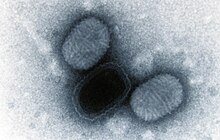传染性软疣病毒
传染性软疣病毒(MCV) 是痘病毒科的一种病毒,会使人类患上传染性软疣。传染性软疣病毒与痘病毒科的其他病毒有着复杂的结构,包括表面的膜,核心,以及侧体。病毒可能以包涵体或出芽等形式在宿主细胞膜内部成熟,并在短时间内散发大量病毒。据测量,传染性软疣病毒的直径约为200纳米,长度约为320纳米,高度则在100纳米左右。[1]
| 传染性软疣病毒 | |
|---|---|

| |
| 电子显微镜下的传染性软疣病毒 | |
| 病毒分类 | |
| (未分级): | 病毒 Virus |
| 域: | 多变 DNA 病毒域 Varidnaviria |
| 界: | 班福病毒界 Bamfordvirae |
| 门: | 核质病毒门 Nucleocytoviricota |
| 纲: | 痘疹病毒纲 Pokkesviricetes |
| 目: | 克希特恩病毒目 Chitovirales |
| 科: | 痘病毒科 Poxviridae |
| 属: | 软疣痘病毒属 Molluscipoxvirus |
| 种: | 传染性软疣病毒 Molluscum contagiosum virus
|

临床表现可用于诊断传染性软疣;传染性软疣病毒不能进行常规培养,手术活检可进一步进行诊断。
传染性软疣病毒共有4种,分别是MCV-1型、MCV-2型、MCV-3型和MCV-4型。MCV-1型是人类感染最普遍的;MCV-2型常见于成人主要通过性传播。[2][3][4] PCR技术可帮助确定并区分引起病变的是哪一种类型的MCV。[5][6][7]
基因组
编辑基因组为不分段的单分子线性双链DNA,由180000–200000个核苷酸组成。不同核苷酸之间通过共价键连接两端边缘以及重复复杂的序列。其中有160个基因已被确定。[8]
动物病毒
编辑有一种动物病毒可以使马和驴患上与传染性软疣类似的疾病。[9][10][11] DNA研究表明,该病毒与MCV是密切相关的。[12]
参考
编辑- ^ Büchen-Osmond, C. (Ed) (2003). 00.058.1.07.001. Molluscum contagiosum virus. In: ICTVdB - The Universal Virus Database, version 3. Büchen-Osmond, C. (Ed), ICTVdB Management, Columbia University, New York, USA
- ^ Porter CD, Muhlemann MF, Cream JJ, Archard LC. Molluscum contagiosum: characterization of viral DNA and clinical features. Epidemiol. Infect. 1987, 99 (2): 563–7. PMC 2249301 . PMID 2824227. doi:10.1017/S0950268800068072.
- ^ Yamashita H, Uemura T, Kawashima M. Molecular epidemiologic analysis of Japanese patients with molluscum contagiosum. Int. J. Dermatol. 1996, 35 (2): 99–105. PMID 8850036. doi:10.1111/j.1365-4362.1996.tb03270.x.
- ^ Agromayor M, Ortiz P, Lopez-Estebaranz JL, Gonzalez-Nicolas J, Esteban M, Martin-Gallardo A. Molecular epidemiology of molluscum contagiosum virus and analysis of the host-serum antibody response in Spanish HIV-negative patients. J. Med. Virol. 2002, 66 (2): 151–8. PMID 11782922. doi:10.1002/jmv.2124.
- ^ Nu?ez A, Funes JM, Agromayor M, et al. Detection and typing of molluscum contagiosum virus in skin lesions by using a simple lysis method and polymerase chain reaction. J. Med. Virol. 1996, 50 (4): 342–9. PMID 8950692. doi:10.1002/(SICI)1096-9071(199612)50:4<342::AID-JMV10>3.0.CO;2-K.
- ^ Thompson CH. Identification and typing of molluscum contagiosum virus in clinical specimens by polymerase chain reaction. J. Med. Virol. 1997, 53 (3): 205–11. PMID 9365883. doi:10.1002/(SICI)1096-9071(199711)53:3<205::AID-JMV4>3.0.CO;2-C.
- ^ Trama JP, Adelson ME, Mordechai E. Identification and genotyping of molluscum contagiosum virus from genital swab samples by real-time PCR and Pyrosequencing. J Clin Virol. 2007, 40 (4): 325–9. PMID 17997134. doi:10.1016/j.jcv.2007.09.007.
- ^ Thompson CH. Molluscum contagiosum: new perspectives on an old virus. Curr. Opin. Infect. Dis. 1999, 12 (3): 185–9. PMID 17035777. doi:10.1097/00001432-199906000-00005.
- ^ Van Rensburg IB, Collett MG, Ronen N, Gerdes T (1991) Molluscum contagiosum in a horse. J S Afr Vet Assoc 62(2):72-74
- ^ Lange L, Marett S, Maree C, Gerdes T (1991) Molluscum contagiosum in three horses. J S Afr Vet Assoc 62(2):68-71
- ^ Cooley AJ, Reinhard MK, Gross TL, Fadok VA, Levy M (1987) Molluscum contagiosum in a horse with granulomatous enteritis. J Comp Pathol 97(1):29-34
- ^ Thompson CH, Yager JA, Van Rensburg IB (1998) Close relationship between equine and human molluscum contagiosum virus demonstrated by in situ hybridisation. Res Vet Sci 64(2):157-161